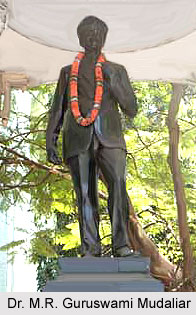 Dr. M.R. Guruswami Mudaliar was a medical practitioner of 20th century. He worked brilliantly even at the time when the higher slots of the medical profession in the Madras Presidency were dominated by British. He along with his contemporary Dr Sarukkai Rangachari became unforgettable icons of the medical world in Madras. Both of them are still remembered by the old-timers of the Madras Presidency.
Dr. M.R. Guruswami Mudaliar was a medical practitioner of 20th century. He worked brilliantly even at the time when the higher slots of the medical profession in the Madras Presidency were dominated by British. He along with his contemporary Dr Sarukkai Rangachari became unforgettable icons of the medical world in Madras. Both of them are still remembered by the old-timers of the Madras Presidency.
In the 20th century, the Britishers used to capture the higher slots of the medical profession. It was no different in Madras. These British people came all the way to India and in particular to Madras to work for the provincial government and its hospitals in several cities and towns. The Civil Service Cadre called `Indian Medical Service` was also dominated by them. But Guruswami Mudaliar somehow managed to make a place of his own in the medical world of Madras and became a legendary status and stature of the city.
Dr. Guruswami Mudaliar became the first Indian during the British rule to get the post of Professor of Therapeutics in the Madras Medical College. This post was regarded to be a very high position and of high status, which was earlier occupied only by the British.
It was a great achievement for a mere Indian in those days. He was very brilliant and talented in medical skills and he had an in-depth knowledge on the subject. Therefore, he deserved to be on that highly respected post.
Dr. Guruswami Mudaliar was born in Nalamangala village in Mysore. It was then ruled by some king of Mysore. Ramaswamy Mudaliar was his father, who was a successful contractor of Mysore. Guruswami`s father had two wives as the culture prevailed in those days among the wealthy people of the society. Guruswami was the son by the second wife.
During Dr. Guruswami Mudaliar`s time, the Nalamangala village was truly rural with no facilities for him to study. He went to a school in a nearby small town walking several miles everyday. He relocated to Bangalore after finishing high school studies and joined the famous Central College there. He studied there for four years and took his B.A. degree with flying colors. After that he moved back to Madras and joined the Madras Medical College. There he stood first in the Presidency College and it indicated his brilliant future career in the world of medicine. Then he was appointed in the British Indian Medical department and worked for many years at the Tanjore (now Tanjavur) Government Hospital.
Dr. Guruswami Mudaliar was a simple person. His appearance, dress, lifestyle was contradictory to his status in the profession and his brilliance. He never took the medical profession as a money-earning mission. It was for him a medium to serve the suffering people and the society. He treated many poor patients without any fees in return. He was a rich doctor but was an idealist in nature and was very contempt with whatever he got.
Once at a noted Tamil family weekly magazine named `Ananda Vikatan` interviewed Dr. Guruswami Mudaliar. In that particular interview, he told the interviewer that the Elkosin tablet was the best and recommended medicine to take even when one`s neighbour was struck by the epidemic `flu` disease. This statement by him created sensation all over the Madras Presidency and other parts in the country and abroad where Tamil was spoken. Most of the local doctors went against this. They criticised Doctor Guruswami Mudaliar saying that it was against medical ethics and code to prescribe a branded tablet in a magazine article. While replying on the issue, Dr. Guruswami Mudaliar said that for him the healthcare of fellow men was supreme and not if a tablet was branded or not.
Even though he belonged to a rich family, he led an economical life. He advised his friends and relatives to remain contented in life and not to show off their money and indulge in lavish expenditure. Due to his early days in Mysore, he was fluent in Kannada and certainly in Tamil, and English. As he belonged to an orthodox tradition-bound Mudaliar family, Guruswami Mudaliar also learnt Sanskrit and was well versed in ancient epics and religious texts. He was very much fascinated with `Bhakthi` songs.
Dr. Guruswami Mudaliar died in 1958 at an age of 78 years. After his death, an over-bridge was erected in his memory in the Kilpauk area in Chennai, where he lived and it was named after him as `Guruswami Bridge`.



















